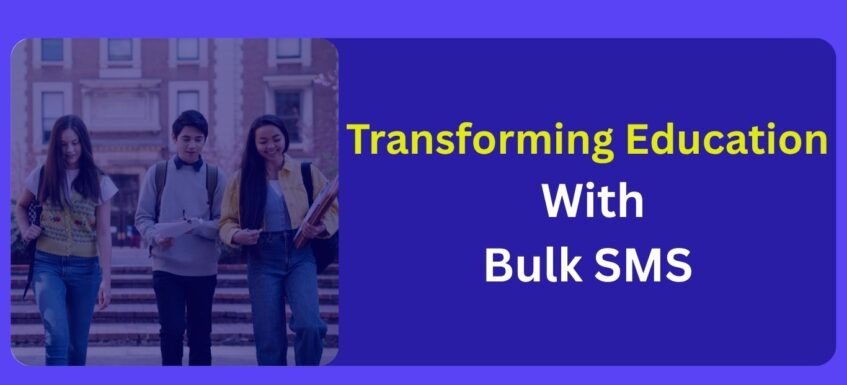Education has advanced significantly from the days of chalkboards and paper notices. Today, schools and universities rely heavily on digital tools to connect with students and parents. Among these tools, Bulk SMS stands out as a quick, simple, and cost-effective way to stay in touch. Its popularity grows because it offers immediate communication — which is critical in schools. This article explores how Bulk SMS is transforming education, showcasing its many benefits and practical uses.
The Role of Bulk SMS in Education Sector
The Evolution of Communication in Education
Long ago, schools used paper notices or phone calls to inform parents about events. Now, everything is digital. Email, social media, and instant messaging are common. Among these, SMS remains powerful because it reaches people directly on their phones. Unlike emails that can get lost or ignored, SMS has a high chance of being seen and read quickly. Schools use this to share updates, reminders, and urgent alerts efficiently.
Benefits of Using Bulk SMS for Educational Institutions
Bulk SMS saves money and time. Sending messages in large numbers doesn’t cost much and delivers instantly. Open rates for SMS are around 98%, much higher than emails. This means almost everyone opens and reads these messages. Using SMS improves parent engagement, keeps students informed, and helps staff stay coordinated. It’s also reliable during noisy or emergency situations when quick information is needed.
Real-world Examples of Successful Implementation
Some schools saw a big rise in attendance after sending SMS reminders for classes or exams. Others used bulk SMS to notify parents about upcoming events or delays. Universities have streamlined communication by quickly sharing exam schedules or result announcements. These examples show how SMS can make communication faster, clearer, and more effective.
Key Features and Functionalities of Bulk SMS Platforms in Education
Customization and Personalization
Educational institutions can send targeted messages to specific groups such as students, parents, or staff. Personalizing messages improves engagement. For instance, sending a child’s specific exam date or fee reminder makes the message more relevant. It helps prevent messages from feeling generic or spam-like.
Automated and Scheduled Messaging
Scheduling messages saves time and ensures important notices go out at the right moment. Automated reminders for exams, assignment deadlines, or fee payments reduce late submissions or missed deadlines. You can plan messages ahead of time and automate their delivery during peak engagement hours, increasing chances of response.
Two-way Communication Capabilities
Effective SMS platforms allow responses from recipients. Students or parents can reply to inquiries or provide feedback. Schools can run quick surveys or gather important input via two-way messaging. This creates a more interactive and engaging communication loop.
Practical Applications of Bulk SMS in the Education Sector
Student Attendance and Engagement
Schools can send alerts about attendance, prompting students or parents to respond or take action. Reminders for classes or exams keep students on track. Quick updates about upcoming events or changes keep everyone engaged and informed.
Emergency and Security Alerts
During emergencies, information must reach people instantly. SMS allows schools to send security alerts about weather, lock-downs, or other safety issues within seconds. This immediate communication can save lives and keep everyone safe during crises.
Administrative Notifications
Renting to parents a tool for sending fee reminders or exam schedules can cut down administrative burdens. Schools can quickly share results, policy updates, or important notices. This keeps everyone on the same page without delays or confusion.
Parent-Teacher Communication
Parents receive regular updates on their children’s progress. Teachers can send short messages about behavior, attendance, or upcoming tests. Instant notifications help parents stay involved and supportive of their child’s education.
Best Practices for using Bulk SMS in educational institutions
Compliance and Ethical Considerations
Before sending messages, make sure you respect privacy laws like GDPR. Get consent from parents and students before adding them to SMS lists. Avoid spamming by ensuring messages are relevant and timely.
Crafting Effective SMS Campaigns
Write clear, short, and direct messages. Use simple language and a call to action — like “Reply now” or “Visit the link.” Avoid confusing jargon. Keep messages warm and friendly to encourage responses.
Integration with Other Educational Tools
Combine SMS with platforms like email, learning apps, or school portals for a smooth experience. Use data analytics to see which messages work best. Over time, you can refine your strategy based on what gets the best engagement.
Measuring Success and ROI
Track delivery rates and responses to see how well your messages are doing. Notice if attendance or participation improves after campaigns. This helps justify the investment and guides future communication plans.
Conclusion
Bulk SMS is revolutionizing how educational institutions communicate. It simplifies and ensures the delivery of urgent and vital messages. Schools that adopt SMS see better attendance, faster notifications, and increased parent involvement. For any school or university, integrating Bulk SMS can significantly improve safety, engagement, and overall management. Moving forward, advances in messaging will further improve how schools connect with their communities. If you want to boost your school’s communication, start exploring Bulk SMS Providers today. It’s a simple step toward a more connected, efficient educational environment.

*
*